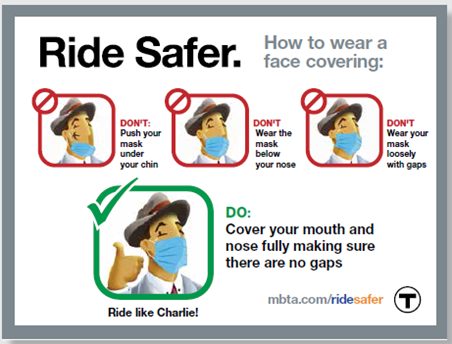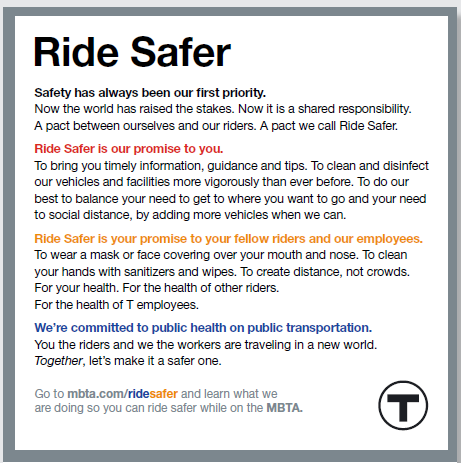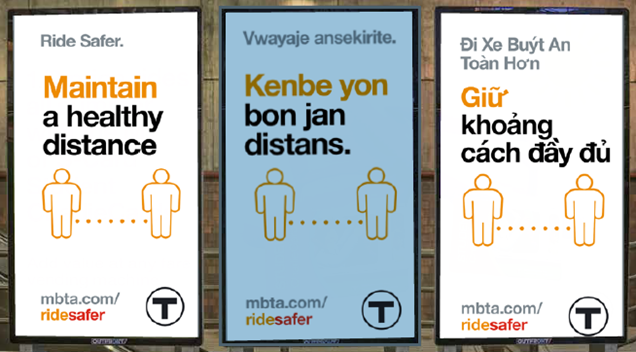You Can Ride Safer with the MBTA
October 28, 2020
WRITTEN BY CAITLIN ALLEN-CONNELLY, Project Director
 Safety First
Safety First
On any given day pre-COVID-19, the MBTA’s most important focus was providing safe and reliable service throughout the Greater Boston area. The onset of the pandemic brought this critical task to a new level and cost.1
Like many transit agencies, it was the first time the T had to respond to a public health crisis of this magnitude. To their credit, the MBTA was swift to enact initial mitigation actions to help prevent the spread of the virus across the entire system. The T is continuing these efforts and also responding to changing demand and ridership patterns to provide adequate service during the pandemic, manage workforce impacts, and put in place effective crisis communication.
Communication is Vital for Today’s Riders and Tomorrow’s Commuters
The dissemination of information during a crisis is absolutely critical to reassure the public and to ensure safety protocols are being followed and respected. For the T, communication and outreach had to target and quickly reach employees as well as customers. During the lockdown, the T relied on its website, weekly videos from the General Manager, and social media to keep riders informed about service and mitigation measures. As the Commonwealth began its phased reopening, the MBTA launched the Ride Safer campaign to communicate the agency’s extensive actions to keep the transit system safe.
The Ride Safer campaign is more than just an outreach effort—it is a pact between the MBTA and riders. The campaign lays out what measures the T is undertaking and calls on riders and employees to do their part—by wearing face coverings, maintaining physical distance, and practicing hand hygiene—to keep the system safe for all.
To help support the implementation of some protocols, the MBTA makes face coverings available to all employees, has organized free face covering distributions for riders and installed hand sanitizer units in high-volume stations. It has also launched technology to alert riders about real-time crowding on buses and recent crowding trends on the subway. A Better City would like to see a continuation and expansion of these efforts.
Danny Levy, Chief Customer Officer, who leads the T’s Ride Safer campaign, says the top priority today is making sure current riders are aware of and following the agency’s safety measures and protocols. Once the Commonwealth enters Phase 4 of the reopening plan, she noted, the campaign will expand its focus to welcome back riders.
Spreading the Word
The Ride Safer campaign uses a combination of in- and outside station signage, vehicle signage, billboards, social media, and videos to spread the word. The focus of the messaging is on face coverings, physical distancing, and hand hygiene. Right now, most materials are only available in English, with the exception of in-station digital signs that provide content in six foreign languages. A Better City would like to see the MBTA translate other signage, add visual physical distancing indicators to vehicles, and put MBTA ambassadors on subway platforms to help spread out riders.2
Beyond the visual indicators the campaign uses to raise awareness, the Ride Safer campaign serves as the overarching framework for communicating the T’s broad range of COVID-19 response measures, including important details on service levels, crowding, and safety response measures, which reside primarily on the T’s website. The T is looking at innovative solutions to disseminating via community outreach and is seeking partners like the business community to help get the word out about the Ride Safer campaign. A Better City supports such collective action.
 MBTA’s Safety Pledge
MBTA’s Safety Pledge
Most of today’s riders are on public transit because they don’t have another viable option, and they need to know what the T is doing to ensure their safety. Tomorrow’s riders want reassurance that returning to public transportation won’t mean risking their own health. The good news for all riders is that the latest research indicates that with the right precautions, people can ride public transit safely during the pandemic, and the MBTA is participating in the APTA Health & Safety Commitments Program, which is pledged to reassure passengers they are taking all measures to operate safely during the pandemic. 3 So what are the right precautions and what is the MBTA doing to fulfill their Ride Safer commitment? The table below outlines the actions the T is taking to keep the system safe.
Find out More
CATEGORY |
MBTA ACTIONS4 |
ADDITIONAL RESOURCES |
CLEAN STATIONS & VEHICLES |
All business locations, including the RIDE Eligibility Center and CharlieCard store, are being disinfected every 24 hours. All high-contact areas at subway stations (handrails, fare gates, and fare vending machines) are being cleaned every 4 hours. All MBTA fleet vehicles (buses, trolleys, subway cars, Commuter Rail coaches, ferries, and RIDE vehicles) are being disinfected on a daily basis. |
|
VENTILATION |
Station doors open to support better airflow. Ventilation on MBTA vehicles meets industry standards; however, the T is committed to implementing additional measures for increased safety during the pandemic. |
|
PROTECTIVE BARRIERS, DECALS, & FACE COVERING REQUIREMENT |
All transit vehicles have protective barriers to help maintain distance between riders and operators, allowing us to resume front-door boarding on buses and at street-level trolley stops. Riders who are able should board at the front door and exit at the rear door. The T requires face coverings for employees and riders and T provides all employees with PPE (see Healthy Workforce). The T has also organized the distribution of PPE to riders on several occasions and hopes to organize future distributions |
|
HAND SANITIZER |
Hand sanitizing dispensers, disinfectant wipes, and cleaning sprays deployed at MBTA facilities and stations throughout the system. Cleaning crews maintain and refill hand sanitizer dispensers on a regular basis. |
|
BUS/SUBWAY CROWDING |
Temporarily redefined crowding standards for bus and subway to allow for physical distancing.5 Launch of real-time crowding app for bus and historic crowding data for subway. Temporary Crowding Standards - 40’ Bus – 20 passengers per bus - 60’ Bus – 31 passengers per bus - Green Line Trolley – 46 passengers per trolley - Red Line Car – 66 passengers per car - Orange Line Car – 62 passengers per car - Blue Line Car – 42 passengers per car |
|
SUPPORT |
MBTA Ambassadors in high-volume stations |
|
INCREASED SERVICE |
The T is back to regular service on subway and regular to better service with operational flexibility for buses. The Commuter Rail is operated on a reduced schedule, Ferry service is operating on a reduced schedule for Hingham/Hull and full service for Charlestown, The Ride is booking trips 1-3 days in advance. The T continues to monitor ridership and is currently undertaking an exercise to propose future service levels to address budgetary concerns arising from COVID-19 induced revenue decreases. A Better City does not support permanent cuts or changes that would significantly impact the ability of the MBTA to quickly reinstate service to any mode. |
|
AWARENESS & VISUAL INDICATORS |
Ride Safer, a public service campaign including signage and messaging to promote the importance of keeping a safe distance and wearing face coverings while on the T; a new webpage to provide a behind the scenes look at our efforts to clean and sanitize stations, vehicles, and platforms as well as providing riders with tips, guidance, and information to make their trip on the T safer and more convenient. |
|
HEALTHY WORKFORCE |
The MBTA’s front-line employees drive the buses, operate the subway and commuter trains, maintain vehicles, police the system, and monitor stations and infrastructure. The MBTA is supplying workers with PPE and supplies and offering COVID-19 testing and fever screenings to employees. |
|
SOURCES
1. COVID-19 related expenses for cleaning and disinfecting are costing the T almost $1M a week.
2. Spanish, Portuguese, Haitian Creole, Vietnamese, Chinese, and Arabic
4. Does not include the following Ride Safer action areas: Business Community Outreach and Building a Better T





